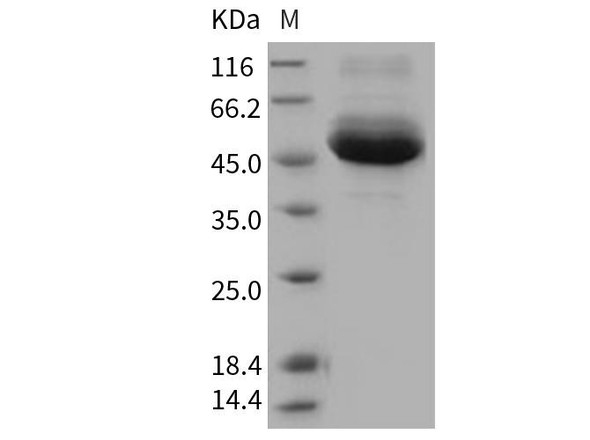Description
Recombinant Human Cathepsin E Protein
The Recombinant Human Cathepsin E Protein is a biologically active recombinant protein that plays a significant role in various cellular processes and signaling pathways in human biology. This protein is widely employed in immunological research, cell biology studies, protein-protein interaction analyses, and therapeutic development, providing researchers with a reliable tool for investigating Cathepsin E function and its implications in health and disease.
This product (SKU: RPCB2019) is produced using HEK293 cells and features a C-His tag for convenient detection and purification. The protein exhibits a calculated molecular weight of 41.78 kDa with an observed molecular weight of 46 kDa under denaturing conditions, achieving ≥ 95 % as determined by SDS-PAGE., ensuring exceptional quality and consistency for research applications.
Key Features
| High Purity by Affinity Chromatography | |
| Mammalian & Bacterial Expression Systems | |
| High lot-to-lot consistency via strict QC |
| Product Name: | Recombinant Human Cathepsin E Protein |
| SKU: | RPCB2019 |
| Size: | 10 μg , 50 μg |
| Reactivity: | Human |
| Synonyms: | CTSE, CATE |
| Tag: | C-His |
| Expression Host: | HEK293 cells |
| Calculated MW: | 41.78 kDa |
| Observed MW: | 46 kDa |
| Gene ID: | 1510 |
| Protein Description: | High quality, high purity and low endotoxin recombinant Recombinant Human Cathepsin E Protein (RPCB2019), tested reactivity in HEK293 cells and has been validated in SDS-PAGE.100% guaranteed. |
| Endotoxin: | < 1 EU/μg of the protein by LAL method. |
| Purity: | ≥ 95 % as determined by SDS-PAGE. |
| Formulation: | Lyophilized from a 0.2 μm filtered solution of 20mM MES, 150mM NaCl, pH 5.5.Contact us for customized product form or formulation. |
| Reconstitution: | Centrifuge the tube before opening. Reconstitute to a concentration of 0.1-0.5 mg/mL in sterile distilled water. Avoid vortex or vigorously pipetting the protein. For long term storage, it is recommended to add a carrier protein or stablizer (e.g. 0.1% BSA, 5% HSA, 10% FBS or 5% Trehalose), and aliquot the reconstituted protein solution to minimize free-thaw cycles. |
| Storage: | Store at -20℃.Store the lyophilized protein at -20℃ to -80 ℃ up to 1 year from the date of receipt. After reconstitution, the protein solution is stable at -20℃ for 3 months, at 2-8℃ for up to 1 week. |
Cathepsin E (CTSE) is a gastric aspartyl protease that functions as a disulfide-linked homodimer. It is a member of the Peptidase C1 family, and has a specificity similar to that of Pepsin A and Cathepsin D. CTSE is localized to the endoplasmic reticulum and Golgi apparatus, while the mature enzyme is localized to the endosome. It is expressed abundantly in the stomach, the Clara cells of the lung and activated B- lymphocytes, and at lower levels in lymph nodes, skin and spleen. CTSE is an intracellular proteinase that have a role in immune function, activation-induced lymphocyte depletion in the thymus, neuronal degeneration and glial cell activation in the brain. Futhermore, it probably involved in the processing of antigenic peptides during MHC class II-mediated antigen presentation.







